| Asian long-horned beetle | |
|---|---|
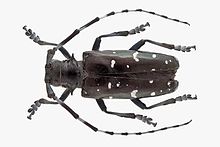
| |
| Scientific classification | |
| Domain: | Eukaryota |
| Kingdom: | Animalia |
| Phylum: | Arthropoda |
| Class: | Insecta |
| Order: | Coleoptera |
| Suborder: | Polyphaga |
| Infraorder: | Cucujiformia |
| Family: | Cerambycidae |
| Tribe: | Lamiini |
| Genus: | Anoplophora |
| Species: | A. glabripennis |
| Binomial name | |
| Anoplophora glabripennis (Motschulsky, 1853) | |
| Synonyms | |
| |
The Asian long-horned beetle (Anoplophora glabripennis), also known as the starry sky, sky beetle, or ALB, is native to the Korean Peninsula, northern and southern China, and disputably in northern Japan. This species has now been accidentally introduced into the eastern United States, where it was first discovered in 1996, as well as Canada, and several countries in Europe, including Austria, France, Germany, Italy and UK.
Taxonomy and description
Common names for Anoplophora glabripennis in Asia are the starry sky beetle, basicosta white-spotted longicorn beetle, or smooth shoulder-longicorn, and it is called the Asian long-horned beetle (ALB) in North America.
Adults are very large insects with bodies ranging from 1.7 to 3.9 cm (0.67 to 1.54 in) in length and antennae which can be as long as 4 cm (1.6 in) or 1.5–2 times longer than the body of the insect. They are shiny black with about 20 white spots on each wing cover and long antennae conspicuously banded black and white. These beetles can fly, but generally only for short distances, which is a common limitation for Cerambycidae of their size and weight. The upper sections of the legs of the adults are whitish-blue. A. glabripennis can be distinguished from related species by the markings on the wing covers and the pattern of the antennae.
Range, habitat, and hosts
The Asian long-horned beetle is native to eastern Asia, primarily in eastern China and Korea. This species was known from Japan in the mid-1800s, but may or may not be native there. It is invasive outside its native range.
In its native range, Anoplophora glabripennis primarily infests plants like maple, poplar, willow, and elm trees. In the United States, A. glabripennis has completed development on species of these genera and also Aesculus, Albizia, birch, katsura, ash, planes, and Sorbus. In Canada, complete development has been confirmed only on maple, birch, poplar, and willow, although oviposition has occurred on other tree genera. Maple is the most commonly infested tree genus in North America, followed by elm and willow. In Europe, complete development has been recorded on maple, Aesculus, alder, birch, hornbeam, beech, ash, planes, poplar, Prunus, willow, and Sorbus. The top five host genera infested in Europe, in decreasing order, are maple, birch, willow, Aesculus, and poplar. Not all poplar species are equally susceptible to attack. Other economically important trees attacked include apple (Malus domestica), mulberry (Morus alba), stone fruits (Prunus spp.), pear (Pyrus spp.), roses (Rosa spp.), and black locust (Robinia pseudoacacia).
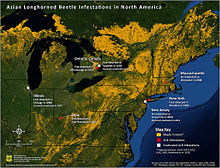
In North America, established populations were first discovered in August 1996 in Brooklyn, New York and has since been found in other areas of New York, New Jersey, Massachusetts, Illinois, Ohio, and Ontario in Canada. However, it has also been eradicated from some regions within these states and provinces. The first confirmed detection in South Carolina was June 4, 2020, at a residence in Hollywood, Charleston County. As a result both Clemson University's State Crop Pest Commission (which regulates crop pests for the state government) and the federal APHIS declared a quarantine.
In Europe, established populations have been found in Austria (in Braunau am Inn in 2001), Belgium, France, Germany, Italy, Switzerland, and the United Kingdom, though the beetle had also been intercepted in areas through inspection of international trade goods such as wood packaging. In January 2021 Austria was declared free of them after 4 years (2 life cycles) of no detections in Gallspach, the last Austrian infestation.
Life cycles

Adult females lay 45–62 eggs in their lifetime by chewing a small pit through the bark of the host tree to the cambium and lay one 5–7 mm (0.20–0.28 in) long egg underneath the bark in each pit. Eggs hatch in 13–54 days depending on temperature. Eggs that have not developed enough, such as those laid in late summer or early fall, will overwinter and hatch the following season.
Larvae are cylindrical and elongate and can be 50 mm (2.0 in) long and 5.4 mm (0.21 in) wide. Larvae first create a feeding gallery in the cambial region, but more mature larvae tunnel to the heartwood as they feed. Larvae go through at least five instars over 1–2 years; which can vary due to host or temperature conditions. Larvae expel frass from their tunnels near the original oviposition site. A larva can consume up to 1,000 cubic cm of wood in its lifetime. Asian long-horned beetle larvae do not pupate before they reach a critical weight, so additional larval instars can occur.
Pupation usually occurs in spring at the end of the larval tunnel in the sapwood, eclosion occurs 12–50 days later, and adults will chew out of the tree approximately one week after eclosion. Adults feed on leaf petioles and can chew through bark on small branches to feed on the vascular cambium. Eggs, larvae or as pupae can overwinter within the tree. In their overwintering phase, pupae are inactive, and development does not occur. They resume their life cycle when temperatures are above 10 °C (50 °F).
Upon emergence, adult females can copulate, although an obligatory maturation period is required for feeding after emergence for ovarian maturation. Laboratory studies have estimated the female maturation period lasts 9–15 days. Adult males have mature spermatozoa before emergence, and feeding is necessary only to sustain their normal activity. Adults typically lay eggs on the plant they developed on during immature stages rather than colonizing new plants unless population density is high or the host plant is dead. However, when they do disperse, they can travel up to approximately 2.5 km (1.6 mi) from their host tree in a growing season in search of new hosts, although in a mark-recapture experiment about 98% of adults were recaptured within 1 km (0.62 mi) of their release point. Adults will typically infest the crown and main branches first and will begin to infest the trunk as the crown dies. Adult longevity and fecundity are influenced by conditions such as the larval host plant and temperature. Laboratory reared males and females can live up to 202 and 158 days, respectively.
-
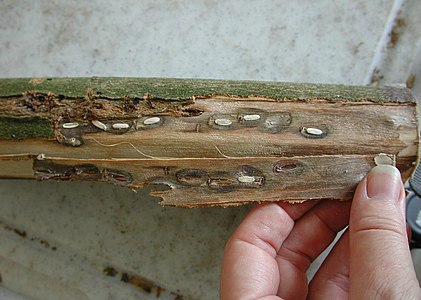 Eggs within pits with the bark removed.
Eggs within pits with the bark removed.
-
 Multiple instars removed from gallery.
Multiple instars removed from gallery.
-
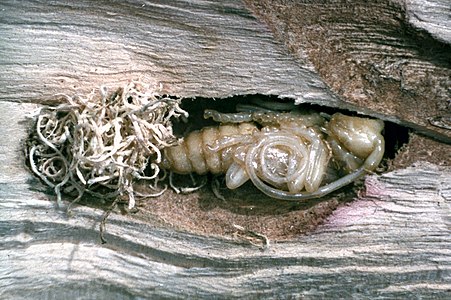 Pupa within its pupal chamber with frass.
Pupa within its pupal chamber with frass.
-
 Adult beetle.
Adult beetle.
As an invasive species
Due to high tree mortality caused by larval feeding outside its native range, A. glabripennis can change both forest and urban ecosystems. In the United States, it can potentially destroy 30.3% of urban trees and cause $669 billion in economic loss. Early detection is used to manage infestations before they can spread.
Monitoring
Tree infestation can be detected by looking for exit holes 3/8 to 3/4 inches in diameter (1–2 cm) often in the larger branches of the crowns of infested trees. Sometimes sap can be seen oozing from the exit holes with coarse sawdust or "frass" in evidence on the ground or lower branches. Dead and dying tree limbs or branches and yellowing leaves when there has been no drought also indicate A. glabripennis infestation. Traps can also be used containing a pheromone and a plant kairomone to attract nearby adults. Some acoustic sensors can also differentiate larval feeding within trees. Dogs can also be trained to detect the smell of frass on trees.
Workers have found and reported infested material in warehouses in CA, FL, IL, IN, MA, MI, NC, NJ, NY, OH, PA, SC, TX, WA, and WI in the United States, and in the Greater Toronto Area in Ontario, Canada. After an aggressive containment program and with the last confirmed sighting in 2007, Canada declared itself free of the beetle on April 5, 2013 and lifted restrictions on the movement of tree materials.
In September 1998, US customs regulations were changed to require wooden packing materials from China be chemically treated or kiln-dried to prevent further infestations of the Asian long-horned beetle from arriving.
Quarantine
Quarantines have been established around infested areas to prevent accidental spread of A. glabripennis by humans. The use of solid wood packing materials for maritime shipping is regulated for adequate treatment methods at certain ports.
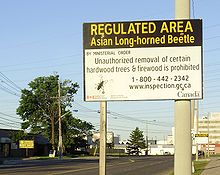
Management
All infested trees should be removed by certified tree care personnel to ensure that the process is completed properly, and chipped in place, their stumps ground to below the soil level. Insecticides such as imidacloprid, clothianidin, dinotefuran have been used to target adult beetles in canopies or as trunk injections to target larvae. Insecticides within the tree may not translocate evenly, which allows some A. glabripennis to survive treatments. Combined with efficacy concerns, high cost, and non-target effects on other insects, widespread prophylactic treatment of trees in an infestation area concern scientists.
Over 1,550 trees in Chicago have been cut down and destroyed to eradicate A. glabripennis from Chicago. In New York, over 6,000 infested trees resulted in the removal of over 18,000 trees; New Jersey's infestation of over 700 trees led to the removal and destruction of almost 50,000 trees, but infested trees continue to be discovered.
Some resistant trees have been developed that quickly fill oviposition pits with sap or produce callous tissue that encases and kills eggs. Non-host species are typically used to replace removed trees.
Biological control has also been considered in some areas such as China. Fungi, such as Beauveria brongniartii, can increase mortality in larvae and adults while Metarhizium brunneum and Beauveria asiatica can reduce adult survival time. Most parasitoids in the native range of A. glabripennis have a broad host range, and are not suitable as classical biological control agents. Woodpeckers can also be a significant source of mortality. Countries working towards eradicating A. glabripennis typically do not initially utilize biological control.
Eradication
In areas such as North America where infestations are small, A. glabripennis can potentially be eradicated. As trees are removed or treated, all host trees on public and private property located within an established distance from an infested area are surveyed by trained personnel. Infested areas are re-surveyed at least once per year for 3–5 years after the last beetle or infested tree is found.
In the US, A. glabripennis has been eradicated from Islip, Manhattan, Staten Island, Chicago and Boston. In Canada, it was declared eradicated in Toronto and Vaughan, Ontario, but it was rediscovered there in 2013. In 2019, the U.S. Department of Agriculture declared New York City free of the beetle after a 23-year eradication effort. In June 2020, Marie-Claude Bibeau (the Minister of Agriculture and Agri-Food) and Seamus O'Regan (the Minister of Natural Resources) declared that A. glabripennis had been eradicated in Mississauga and Toronto, the only two areas of known infestation in Canada.
In 2012, the first recorded outbreak of Asian longhorn beetle in the UK was found at Paddock Wood in Kent, near small commercial premises that had imported stone from China. Novel techniques used to control the outbreak included the use of two detection dogs trained in Austria that can smell the beetles in trees. At the end of the first year’s survey, 1,500 trees had been felled and burned from fields and roadsides and 700 from commercial premises and private gardens. The beetle was declared eradicated in 2019.
See also
- Citrus long-horned beetle
- Emerald ash borer
- Forest disturbance of invasive insects and diseases in the United States
References
- "Family Cerambycidae | SubFamily Lamiinae". bezbycids.com Cerambycidae Entire Catalog.
- ^ Meng, P.S.; Hoover, K.; Keena, M.A. (2015). "Asian Longhorned Beetle (Coleoptera: Cerambycidae), an Introduced Pest of Mapleand Other Hardwood Trees in North America and Europe". Journal of Integrated Pest Management. 6 (4). doi:10.1093/jipm/pmv003.
- "Asian longhorned beetle, Anoplophora glabripennis Coleoptera: Cerambycidae". www.invasive.org.
- "Cerambycidae (Longhorns)". titan.gbif.fr.
- ^ Robert A. Haack; Franck Hérard; Jianghua Sun; Jean J. Turgeon (2009). "Managing invasive populations of Asian long-horned beetle and citrus long-horned beetle: a worldwide perspective". Annual Review of Entomology. 55 (1): 521–546. doi:10.1146/annurev-ento-112408-085427. PMID 19743916.
- "Anoplophora glabripennis (Asian longhorned beetle)". Invasive Species Compendium (ISC). CABI (Centre for Agriculture and Bioscience International). 2021-11-16. Retrieved 2022-05-19.
- September 18, 2003 Asian Longhorned Beetle discovered in York Region Archived January 14, 2006, at the Wayback Machine
- "Press Release". Nj.gov. 2002-10-11. Archived from the original on 21 July 2011. Retrieved 2011-06-22.
- "August 7, 2008 Pest alert: Asian long-horned beetle detected in Massachusetts". Massnrc.org. 2008-08-07. Archived from the original on 23 June 2011. Retrieved 2011-06-22.
- "August 7, 2008 Tree-devouring Asian beetle found in Worcester". Boston.com. 2008-08-07. Retrieved 2011-06-22.
- "Browning in Greendale". Telegram.com. August 8, 2008. Archived from the original on 2012-02-13. Retrieved 2011-06-22.
- ^ "USDA Declares New York City Free of the Asian Longhorned Beetle". U.S. Department of Agriculture. 2019-10-11. Retrieved 2019-10-11.
- "Asian Longhorned Beetle - Public". Clemson University State Crop Pest Commission. 2020-10-20. Retrieved 2020-11-11.
- "Regulation 27-58 – Asian Longhorned Beetle Quarantine" (PDF).
- "APHIS Establishes an Asian Longhorned Beetle (Anoplophora glabripennis) Quarantine Area in Charleston County, South Carolina". USDA Animal and Plant Health Inspection Service. 2020-10-15. Retrieved 2020-11-11.
- "Asian Longhorned Beetle – A New Invasive Tree Pest In South Carolina". Home & Garden Information Center | Clemson University, South Carolina. 2020-06-16. Retrieved 2020-11-11.
- Reagan, Nick (2020-08-28). "Officials confirm infestations of Asian Longhorned Beetle on Johns Island, Hollywood". WCSC-TV. Retrieved 2020-11-11.
- ^ "Anoplophora glabripennis eradicated from Austria - EPPO Reporting Service no. 01 - 2021 - Num. article: 2021/006". European and Mediterranean Plant Protection Organization Global Database. 2015-06-09. Retrieved 2021-01-29.
- "Anoplophora glabripennis: procedures for official control". Bulletin OEPP/EPPO Bulletin. 43 (3): 510–517. 2013. doi:10.1111/epp.12064.
- "Anoplophora glabripennis (Asian longhorned beetle)". Retrieved December 10, 2015.
- "Aziatische boktor in Winterswijk". Archived from the original on 23 February 2013. Retrieved 18 August 2012.
- M. A. Keena (2002). "Anoplophora glabripennis (Coleoptera: Cerambycidae) fecundity and longevity under laboratory conditions: comparison of populations from New York and Illinois on Acer saccharum". Environmental Entomology. 31 (3): 490–498. doi:10.1603/0046-225X-31.3.490. S2CID 84329785.
- ^ Jiafu Hu; Sergio Angeli; Stefan Schuetz; Youqing Luo; Ann E. Hajek (2009). "Ecology and management of exotic and endemic Asian longhorned beetle Anoplophora glabripennis". Agricultural and Forest Entomology. 11 (4): 359–375. doi:10.1111/j.1461-9563.2009.00443.x. S2CID 84902418.
- "Asian beetle pest eradicated from Canada". CBC News. 5 April 2013. Retrieved 2013-04-06.
- "Asian Long-horned Beetle eradicated from Canada". News Release. Canadian Food Inspection Agency. 2013-04-05. Archived from the original on 8 April 2013. Retrieved 5 April 2013.
- Aslop, Peter (2009-10-31). "Invasion of the Longhorn Beetles". Smithsonian Magazine. Retrieved 2024-06-14.
- "A Summary of U.S. Entry Requirements According to 7CFR 319.40". Aphis.usda.gov. 1998-12-17. Archived from the original on 6 June 2011. Retrieved 2011-06-22.
- "Requirements for Wood Packing Material Products (SWPM)". Kline.com. Archived from the original on 13 July 2011. Retrieved 2011-06-22.
- Sue Epstein (March 14, 2013). "Asian long-horned beetles booted out of N.J. after decade-long battle". nj.com.
- "June 11, 2010 Detailed Map Showing New York City's Asian long-horned beetle infestation from 2007 to 2010". Pallettruth.com. Archived from the original on 15 July 2011. Retrieved 2011-06-22.
- "Asian longhorned beetle declared eradicated in the cities of Mississauga and Toronto" (Press release). Canada NewsWire. 2020-06-25. Retrieved 2020-06-26.
- "Biological security strategy" (PDF). Home Office, Department of Health and Social Care and Department for Environment, Food & Rural Affairs. 30 July 2018.
- "Eradication of Anoplophora glabripennis from the United Kingdom". EPPO. 2019. Retrieved 4 July 2019.
External links
- Asian longhorned beetle in Europe - life cycle, significance and combat infestation.
- USDA Animal and Plant Health Inspection Service Asian long-horned beetle site.
- Asian Long-horned Beetle, Natural Resources Canada
- Bugged: The Race To Eradicate The Asian Longhorned Beetle Asian long-horned beetle Documentary
- Forest Disturbance Processes - Asian Longhorned Beetle. Archived 2019-07-08 at the Wayback Machine US Forest Service: Northern Research Station
- Species Profile- Asian long-horned beetle (Anoplophora glabripennis), National Invasive Species Information Center, United States National Agricultural Library. Lists general information and resources for Asian long-horned beetle.
- ALB Emergency Quarantine Map
| Taxon identifiers | |
|---|---|
| Anoplophora glabripennis |
|